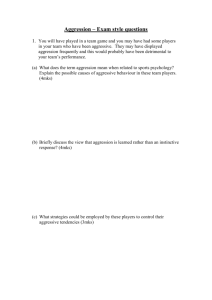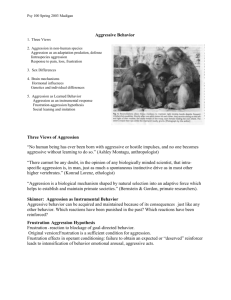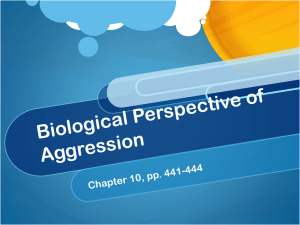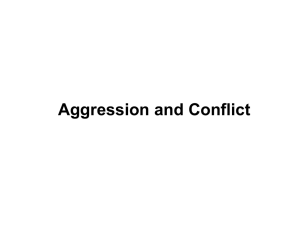Aggression and anti-social behavior
advertisement
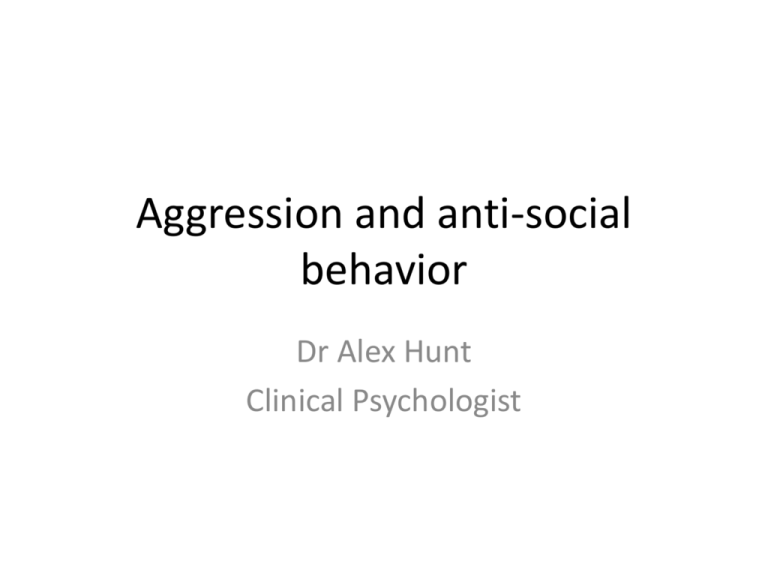
Aggression and anti-social behavior Dr Alex Hunt Clinical Psychologist Defining aggression • Behaviour designed to harm another – Self defence vs unprovoked attack – Same level of aggression, but motive important • Any behaviour who’s proximate intention is to harm another person (Fiske, 2004) • Behaviour either physical or symbolic performed with the intention of harm – Passive aggressive – Attacking – Sarcasm Importance of intention • Widely different motives for aggressive acts – Proximate intention – closest and most immediate – Primary intention – ultimate motive • Primary motives: – Revenge, fame, recognition (boxing, school shootings) – Political and moral (terrorism, religious wars) – Control, threat, self enhancement (domestic violence) • Hostile aggression – aim just to harm or hurt someone (revenge is a dish served cold?) • Instrumental aggression – means to an end (impulsivity) Theories of aggression • • • • • • • Lorenz – Ethological approach Freud – psychoanalytic approach Frustration-aggression hypothesis Aggressive cue theory Operant conditioning Social learning theory Media influence Lorenz-instinct theory • Lorenz theory is based on animal studies • Aggression is instinctive in all species • Believed it is legitimate to make direct comparisons between species • “the fighting instinct in beast and man that is directed against members of the same species” • Important in the evolution of the species • Allows adaption survival – scarce resources, defend territory Thoughts? • Importance of groups, in-groups and outgroups • Behind genocide? Freudian theory • Death instinct – thanatos – an inborn self destructiveness, aim to reduce or destroy tension with the aim of achieving a blissful state • Conflicts with the life instinct, and must therefore be displaced into others or sublimated into other activity • Aggressive energy builds until it needs to be released in some way • Megergee (1966) - Brutally aggressive crime often committed by over controlled individuals… • "The sombre fact is that we are the cruellest and most ruthless species that has ever walked the earth . . . And that although we may recoil in horror when we read in newspapers and history books of the atrocities committed by man upon man, we know in our hearts that each one of us harbours within himself the same savage impulses which lead to murder, torture and war… since he [man] now possesses weapons of unparalleled destructiveness . . . it is not beyond possibility that he may yet encompass the total elimination of homo sapiens.“ (Storr 1968) Appeasement • • • • Eye to eye contact Smiling Mercy Technology distance us from these strategies to reduce violence- missiles , planes, • De-individuation-NATO bombing of Yugoslavia Frustration-aggression hypothesis • Dollard -Aggression is always as a result of frustration and contrariwise the presence of frustration always leads to some form of aggression • Agreed with Freud that aggression is an instinct, he argued that it would be triggered only by frustrating situations and events. • Support from the displacement of aggression – scapegoating, retaliation against an innocent third party when retaliation against the provocation is not possible. Kicking the cat evaluation • Frustration might be an instigator of aggression, but situational factors mitigate it; learned inhibition, fear of retaliation • Frustration leads to arousal, but aggression might be one of many responses, whether it occurs depends on learnt patterns of behavior • Frustration produces different responses in different situations. Aggression more likely if – frustration occurs close to achieving goal – Frustrating event seen as arbitrary or illegitimate Importance of attribution • Cognitive appraisal important • Attribution theory (weiner 1986) Attributions for behaviours are made in terms of – – – – Internal vs. external Global vs. specific Stable vs. unstable Controllable vs. uncontrollable – Berkowitz – frustrator’s behaviour seen as internal controllable and improper = aggression more likely – Mitigating circumstances – changes attribution Aggressive children • Chronically aggressive children have been found to have a hostile attribution bias; see others as acting against them with hostile intent, even in ambiguous circumstances • Aggressive children make rapid attributions based on only some of relevant information relating to perceived threat • Learnt behaviour or more rapid excitatory response? Or both? Aggressive Cue Theory (ACT) • Frustration leads to anger rather than aggression • Anger only converted to aggression when certain cues are present • Cues are environmental stimuli associated with aggressive behaviour or frustrating object or person • Specific features of the situation ‘pull out’ an aggressive response: – Environmental cues associated with aggressive Evaluation of ACT • Stooge experiment on physiological reactions to stress. • Evaluate the other person’s solution to a written problem with electric shock • Half Ps given 1 shock (favourable) other half given 7 shocks (unfavourable) • See either violent film (Champion with Kirk Douglas) or non violent film • Ps then shocked the stooge Evaluation continued.. • More shocks from those that had received more shocks, • more shocks again from those that had viewed the violent film • and more again when the stooge’s name contained either ‘kirk’ or the character ‘kelly’ he played who lost the fight… • …an instance of successful rewarded aggression… Weapons effect… • More shocks when there are apparently unrelated weapons present as opposed to sports gear… • Reliable effect across situations and societies.. • Guns have an effect in their own right on promoting aggression, simply by being there: ‘guns not only permit violence, they can stimulate it as well. The finger pulls the trigger, but the Social learning theory - Bandura • Aggressive behavior is learnt through reinforcement and imitation of aggressive models-Bandura • Imitation is reproduction of learning through observation • Bobo doll experiment-children observed adult model with an inflatable doll. After witnessing violence, more likely to replicate. No violence, no replication. Video – bobo dolls Media and violence • SLT influenced research into affects of watching violence and consequently the affect of watching media with portrayals of violence • • Violence is perceived as more emotional: – When realistic settings – When it is depicted as justified or rewarded – When viewers identify with the characters – When pain and suffering are shown graphically Psychological processes underlying media exposure Underlying process Short term effects 1. Priming of pr-existing cognitions or scripts for behaviour 2. Immediate mimicking of observed behaviour 3. Changes in emotional arousal and the misattribution of that arousal Long term effects 1. Observational learning of behavioural scripts, world schemas and normative beliefs 2. Activation and desensitisation of emotional processes (emotionally blunting) 3. Didactic learning processes Factors affecting exposure to media violence • Cognitive factors mediate the relationship between exposure and response. • How TV violence is perceived and interpreted is important. • Some studies in support, others against. • Again complicated array of factors which come together to make it more likely, including personality, situational, family and cultural factors. Media violence video Deindividualisation • Developed from concept of losing identity in crowds • The individual gets lost in the group, they feel more a part of something bigger and become more anonymous. • This can lead to greater antisocial and aggressive behaviour • Diener 1976 – trick or treaters • Zimbado – deindividualisation and prison experiment. Demand characteristics Deindividualisation • Belgian soldiers – those with hoods on became more self conscious and individualised. Conversely those who wore just usual uniforms stayed deindividualised more likely to be aggressive • Function of uniforms are to deindividualise • Prison uniforms; holocaust; effect of deindividualisation was also to depersonalise them to allow abuse torture etc. Family Background • Norm of family violence – Siblings – Domestic violence – Corporal punishment?




